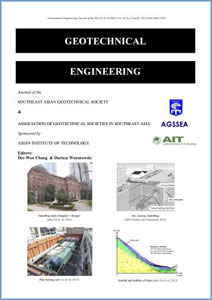Tunneling Induced Deformation of a Historic Building in Shanghai
Main Article Content
Abstract
Tunnelling induced deformations of a historic building, Chongsi Building, in Shanghai, China, are reported. The construction site located in Xuhui District, along the Metro line 11, and at the site the thickness of soft soil layer, soft clay and clayey silt, is about 30 m. The tunnelling method used is the earth pressure balance (EPB) shield tunnelling. The building with masonry structure was built about a century ago, and there were already considerable deformations. Considering this situation, the criteria for total and incremental deformations have been proposed; especially the twist criteria have been newly established and applied to the project. Controlling both the total and incremental deformations is called Dual-control criteria (DCC). The measured maximum settlement, differential settlement, and twist during tunnelling construction were 13.29 mm, 0.67 mm/m, and 3.23×10-5 rad/m respectively. Based on the monitoring results, the deformations of the historic building during and after tunnel construction were very small and, causing no serious damage to the building, and it is considered that the construction control is successful.
Article Details

This work is licensed under a Creative Commons Attribution-NonCommercial-NoDerivatives 4.0 International License.
Copyright © 2019 Association of Geotechnical Societies in Southeast Asia (AGSSEA) - Southeast Asian Geotechnical Society (SEAGS).


